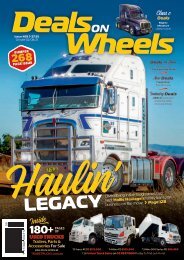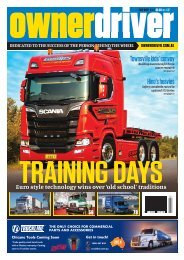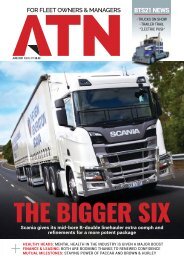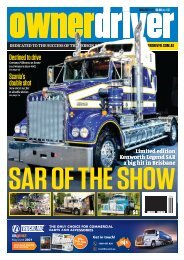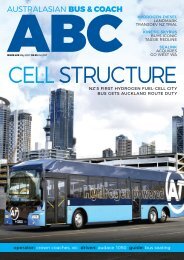You also want an ePaper? Increase the reach of your titles
YUMPU automatically turns print PDFs into web optimized ePapers that Google loves.
We’ve tried to make this vehicle<br />
perform as well as, if not better,<br />
than the diesel<br />
Top: The complete<br />
Hino cabs arrive<br />
from Japan, before<br />
they’re attached to<br />
a chassis during<br />
the 120-hour build<br />
process<br />
Above: SEA Electric<br />
interface displays<br />
speed, range,<br />
charge, and power<br />
both expended<br />
and regenerated<br />
as you drive<br />
Opposite top: The<br />
heart of an SEA300<br />
– motor up back,<br />
fed by battery<br />
packs where the<br />
motor and gearbox<br />
would ordinarily sit;<br />
SEA Electric battery<br />
pack – assembled<br />
and ready to power<br />
a truck<br />
president, operations – Asia Pacific,<br />
Glen Walker explained.<br />
TAKING A DRIVE<br />
Before we pulled out from the factory,<br />
with a plan to hit the Dandenong<br />
Ranges for a strap, we were given a<br />
rundown of the truck from the SEA<br />
Electric team.<br />
Getting it started is no different to<br />
any truck, with a turn of the key but<br />
with an unfamiliar whir as the electric<br />
motor prepares to spin up.<br />
The existing Hino 300 interior<br />
remains largely unchanged, although<br />
some of the factory gauges, such<br />
as fuel and temperature, have been<br />
disconnected – something we’re<br />
told will be removed altogether from<br />
future models.<br />
All battery range and power use<br />
data is displayed on the centre<br />
infotainment screen, which can still<br />
be switched over to radio or other<br />
multimedia displays.<br />
Selecting ‘drive’ is done using<br />
the same button pad those familiar<br />
with this truck’s Hino cousin will be<br />
familiar with, and from there it’s just<br />
matter of ‘go’ and ‘stop’.<br />
Why the Dandenong Ranges?<br />
Why not! We were only able to get<br />
our hands on a freshly assembled<br />
cab-chassis so, without a load on the<br />
back, urban testing seemed no more<br />
appropriate than a scenic drive.<br />
The SEA-Drive Power System<br />
ranges in output, depending on<br />
truck configuration, from 4,500kg to<br />
22,500kg gross vehicle mass (GVM).<br />
But the medium wheelbase SEA<br />
300-85 we tested produced 125kW<br />
and 1,545Nm out of a 100kW/h<br />
battery setup, offering an un-laden<br />
range of up to 250km.<br />
Tare weight on the medium<br />
wheelbase SEA 300-85 is 3,062kg.<br />
With a GVM rating of 7,995kg, this<br />
allows a fairly competitive payload of<br />
4,993kg, depending, of course, on the<br />
body fitted.<br />
Make no mistake, this SEA300<br />
steers, rides and feels identical<br />
to a Hino 300, which is hardly<br />
shocking given the underlying<br />
architecture used.<br />
However, from the moment you<br />
take off, there are two distinct<br />
differences – acceleration and<br />
braking.<br />
It’s an odd feeling, really, having to<br />
remind yourself you’re in a truck. The<br />
acceleration is car-like, effortless<br />
and the lack of momentary drive loss<br />
associated with gear shifts makes<br />
for butter-smooth power delivery.<br />
SEA Electric didn’t set out to build<br />
a performance vehicle and it won’t be<br />
used as such but, by truck standards,<br />
this sets a new benchmark in terms<br />
of acceleration from a standstill.<br />
Speaking of outperforming a<br />
diesel counterpart, the regenerative<br />
braking made up for improvements<br />
in acceleration all while refilling the<br />
figurative fuel tank.<br />
Like a traditional exhaust brake,<br />
flick the left hand stalk down and<br />
you’ve got a two-stage regenerative<br />
braking system.<br />
The braking was probably the<br />
biggest departure from combustion<br />
engine normality when first driving<br />
this truck, as it pulls up with<br />
phenomenal force.<br />
Beyond seldom having to use the<br />
service brakes, we had to actually<br />
accelerate up to stop signs and red<br />
lights downhill, it was that good.<br />
You’ve got every reason to want<br />
to use the regenerative braking on<br />
an electric vehicle, too, as it feeds<br />
energy back into the batteries<br />
- which is all displayed on the<br />
infotainment display and becomes<br />
quite addictive to watch.<br />
“Under braking, a diesel doesn’t<br />
produce more fuel; it disperses<br />
energy by generating heat. What we<br />
do with regenerative braking is, if the<br />
motor is able to produce 1,500Nm of<br />
torque back into the diff, it’s able to<br />
58 <strong>ATN</strong> July 2021 FULLYLOADED.COM.AU




